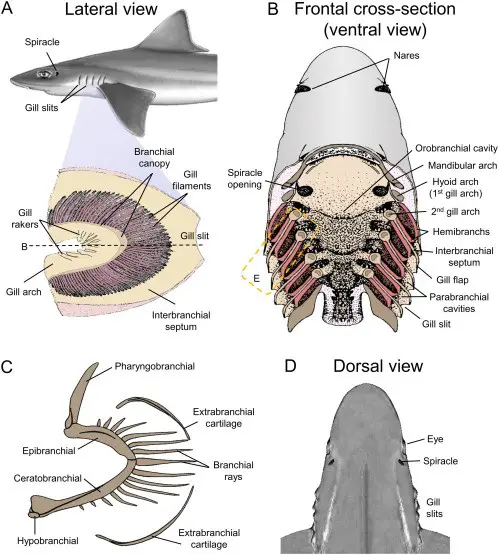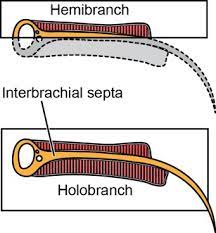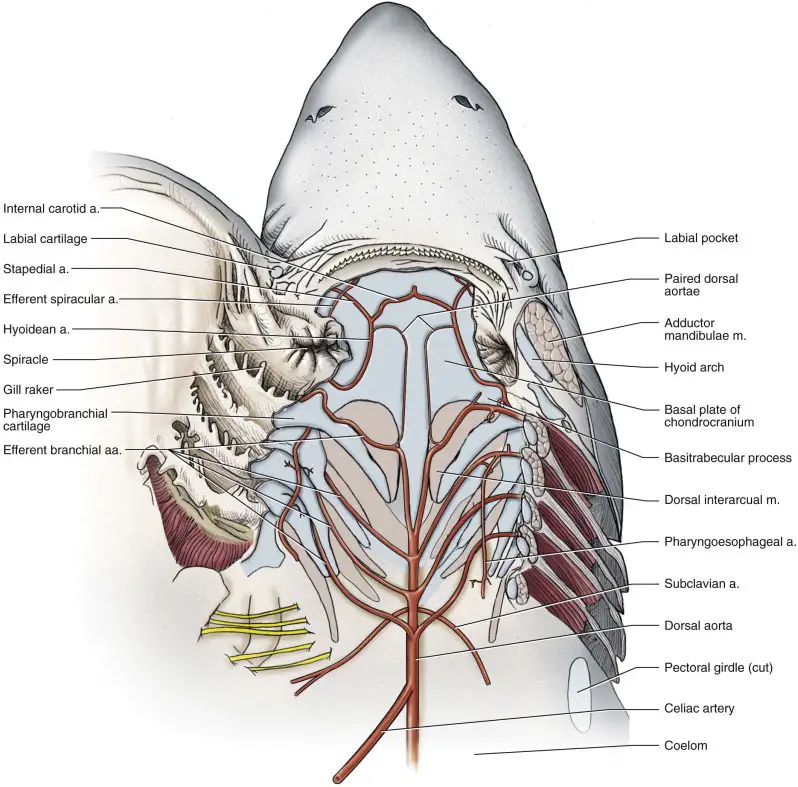Scoliodon lives in aquatic condition so like other fishes they also respire through the gill, the highly vascularized gill take oxygen from the dissolved oxygen in the water and release the metabolic carbon dioxide into the water.
Table of Contents
Primary Respiratory Organ in Scoliodon:
The primary respiratory organ in Scoliodon is five pairs of gill, the gill present inside the gill pouches. On the lateral side of the pharynx, the pharynx connected to the five pairs of gill pouches, behind the hyoid arch, the gill pouches present in series, the gill pouches are compressed anterio-posteriorly.

The gill pouches are connected to the pharynx through the large internal branchial aperture and each gill pouches open outside through the narrow vertical external branchial aperture or gill slits. In between two adjacent gill pouches, a septum is present known as inter-branchial septa is made of connective tissue fibers and muscle fibers that separate each gill pouches from the other.
Cartilaginous visceral arch or gill arch and gill rays support the internal margin of each inter-branchial septa. The mucous membrane of each inter-branchial septa has horizontal numerous leaf-like folding known as gill lamellae or gill filament.
On an inter-branchial septa gill lamellae present on both the anterior side and posterior side, the gill lamellae on the anterior side of inter-branchial septa are known as anterior gill lamellae and the gill lamellae present on the posterior side of an inter-branchial septum are known as posterior gill lamellae.
Each anterior or posterior gill lamellae is called a hemibranch or demibranch, a gill septum with gill arch, and both anterior and posterior gill lamellae together are known as holobranch. In a holobranch, the posterior hemibranch is longer than its anterior hemibranch.

In Scoliodon the hyoid arch only has the posterior demibranch, the next four pairs of branchial septum have both anterior and posterior hemibranch but the fifth branchial septum has no demibranch. In Scoliodon the inter-branchial septa are much longer than both anterior and posterior gill lamellae and form a flap-like extension.
On the anterior portion of each hyoid have a small opening on both the lateral side is actually the oval pit of the spiracle, in Scoliodon spiracle is vestigial. The spiracles in Scoliodon have no gill lamellae, it is actually a vestigial gill pouch. But in other elasmobranchs behind the eyes the spiracles present in which a minute gill lamellae present known as false gill or pseudobranch.
Mechanism of Respiration in Scoliodon:
In Scoliodon the primary respiratory organ is the five pairs of gills, the water current enters into the mouth due to the contraction of the pharyngeal muscle. The water current goes into the pharynx and from there the water enters into gill pouches and from gill pouches the water goes outside through the external gill slits. The muscular contraction of the pharynx creates the pumping activity of the water current and the respiration occurs through two steps.
Inspiration:
When the hypobranchial muscle contract, the gill arch expand, which causes the pulling down of the buccopharyngeal floor and enlarges the buccopharyngeal cavity. The enlargement of the buccopharyngeal cavity creates a negative pressure which creates a water current into the buccal cavity.
Expiration:
When the water current entry into the mouth, the abductor muscle closes the mouth and the inter-branchial muscle reduces the volume of the buccopharyngeal cavity. It pushes the water inside the buccopharyngeal cavity into the gill pouches, through the gill pouches, the water comes outside by the external gill slits.
The spiral is a vestigial organ in Scoliodon but in some cases, the spiracles are used to draw water into the buccopharyngeal cavity.

Respiration in Scoliodon:
The gill lamellae are highly vascularized with a fine network of capillaries, the afferent branchial artery when passing through the gill lamellae, the oxygen mixes into the blood and the carbon dioxide from blood diffuse into the water. The capillary network of gill lamellae comes out as an efferent branchial artery, in this way the gaseous exchange takes place in the branchial system of Scoliodon.
Detailed Study On
Digestive Glands and Feeding Mechanism in Scoliodon
Coelom and Viscera in Scoliodon
Placoid Scales In Scoliodon (Exoskeleton)
Skin of Scoliodon (Integument)
Hi Everyone!!! Welcome to Imaluop. Imaluop always try to learn some new and he want to share to other people. Here we will try to learn various topics on Science, specially on Biological Sciences.